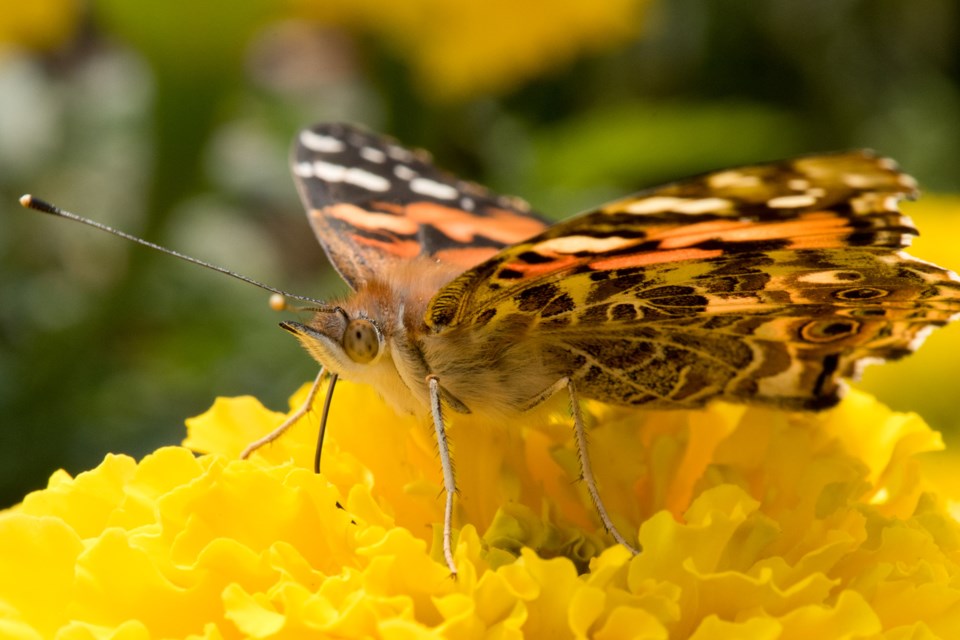Butterfly watch
Local lepidopterists could be in for a treat this summer as experts are predicting a rare wave of painted lady butterflies headed our way in a few weeks.
University of Alberta biologist and butterfly specialist Felix Sperling said that a wave of painted lady butterflies may soon be swooping over Alberta.
The painted lady, a rare sight in Alberta, is easily identified by its pinkish-orange black-and-white wings, big eyestalk clubs, and fat, fuzzy bodies.
Painted lady caterpillars eggs cannot survive Alberta’s winters, so they only appear here as migrants or as the occasional kit-bred one released by a student, Sperling said. They only migrate north if they have a population boom down south, and he suspects one happened in February-March in or around California. Reports from last spring showed them appearing first in Colorado, then Wyoming, then Montana, consistent with a northern migration.
You’ll usually only see a handful make it up to Alberta in any given year, but Sperling said this year there had been sightings near Calgary, Pigeon Lake, Stettler, and across the Edmonton region. (St. Albert naturalist Ludo Bogaert reports that he spotted two in his backyard on July 14.)
“They were clearly the fairly worn specimens that had come in from somewhere else,” he said, so at least some of them had not come from kits.
These migrants would have laid eggs on Canada thistle, which is particularly abundant this year due to all the rain, he added. Some have already hatched into intimidating black spiky caterpillars.
Assuming heavy rains or cold don’t kill the eggs, Sperling said conditions are ripe for a bumper crop of painted ladies in the next four weeks.
Painted lady booms typically happen once every 10 to 15 years in Alberta, with hundreds flying around here during the last major boom back in 2005. Biologist John Acorn said in an email that he was hoping for “spectacular numbers” by August this summer, but was cautious, as the last time he predicted a boom in 2017 it turned out to be a bust.
No matter how many show up, painted ladies are good all around for Alberta, as they eat the invasive Canada thistle, pollinate plants, and help people appreciate nature, Sperling said.
“Their presence here is only good.”
Record heat for June
Humanity saw its hottest June in recorded history this year, and climate scientists say July could soon become the hottest month on record period.
NASA released data Monday showing that the average global temperature last June was 0.93 C above the 1951-to-1980 baseline, shattering the previous 2016 June record of 0.82 C above.
Michael Mann, one of the world’s most respected climate scientists, said on Twitter that July has a good shot at being the hottest month period in recorded history. In another Twitter post, renowned NASA climate scientist Gavin Schmidt predicted that, based on the first six months of this year, 2019 was 90 per cent likely to be warmer than 2018, five per cent likely to set a new record, and 99.9 per cent likely to be in the top five.
The June temperature record is the latest in a long series to fall as the planet continues to heat up due to the climate crisis. NASA reports that the four hottest years on record all happened in the last four years, with 2018 being fourth hottest.
“We just keep racking up more and more warm years,” said University of Lethbridge climate modeller James Byrne.
Byrne said this rising heat was contributing to wild weather around the world, the effects of which could be seen here in the form of more forest fires and more flash floods in Edmonton and Calgary.
“Nothing explains (this temperature trend) except our greenhouse gas emissions, our burning of fossil fuels, and our failure to contain those,” he said.
Global heating is putting huge parts of humanity in “substantial peril” and can rightfully be called a climate emergency, Byrne said. Unless it wants the world to shun its oil and oil jobs, Alberta needs to invest substantially in renewable power to show it’s taking action on greenhouse gases.




